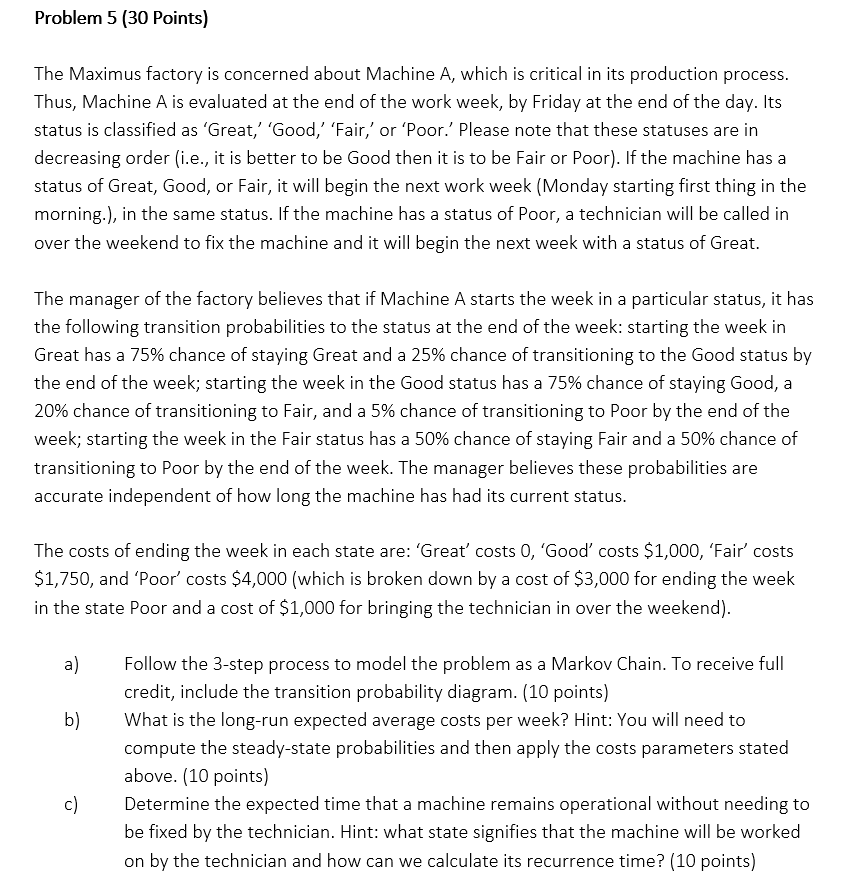
Problem 5 (30 Points) The Maximus factory is concerned about Machine A, which is critical in its production process. Thus, Machine A is evaluated at the end of the work week, by Friday at the end of the day. Its status is classified as 'Great,' 'Good,' 'Fair,' or 'Poor. Please note that these statuses are in decreasing order (i.e., it is better to be Good then it is to be Fair or Poor). If the machine has a status of Great, Good, or Fair, it will begin the next work week (Monday starting first thing in the morning.), in the same status. If the machine has a status of Poor, a technician will be called in over the weekend to fix the machine and it will begin the next week with a status of Great. The manager of the factory believes that if Machine A starts the week in a particular status, it has the following transition probabilities to the status at the end of the week: starting the week in Great has a 75% chance of staying Great and a 25% chance of transitioning to the Good status by the end of the week; starting the week in the Good status has a 75% chance of staying Good, a 20% chance of transitioning to Fair, and a 5% chance of transitioning to Poor by the end of the week; starting the week in the Fair status has a 50% chance of staying Fair and a 50% chance of transitioning to Poor by the end of the week. The manager believes these probabilities are accurate independent of how long the machine has had its current status. The costs of ending the week in each state are: 'Great' costs 0, 'Good costs $1,000, Fair' costs $1,750, and 'Poor' costs $4,000 (which is broken down by a cost of $3,000 for ending the week in the state Poor and a cost of $1,000 for bringing the technician in over the weekend). a) b) Follow the 3-step process to model the problem as a Markov Chain. To receive full credit, include the transition probability diagram. (10 points) What is the long-run expected average costs per week? Hint: You will need to compute the steady-state probabilities and then apply the costs parameters stated above. (10 points) Determine the expected time that a machine remains operational without needing to be fixed by the technician. Hint: what state signifies that the machine will be worked on by the technician and how can we calculate its recurrence time? (10 points) c) Problem 5 (30 Points) The Maximus factory is concerned about Machine A, which is critical in its production process. Thus, Machine A is evaluated at the end of the work week, by Friday at the end of the day. Its status is classified as 'Great,' 'Good,' 'Fair,' or 'Poor. Please note that these statuses are in decreasing order (i.e., it is better to be Good then it is to be Fair or Poor). If the machine has a status of Great, Good, or Fair, it will begin the next work week (Monday starting first thing in the morning.), in the same status. If the machine has a status of Poor, a technician will be called in over the weekend to fix the machine and it will begin the next week with a status of Great. The manager of the factory believes that if Machine A starts the week in a particular status, it has the following transition probabilities to the status at the end of the week: starting the week in Great has a 75% chance of staying Great and a 25% chance of transitioning to the Good status by the end of the week; starting the week in the Good status has a 75% chance of staying Good, a 20% chance of transitioning to Fair, and a 5% chance of transitioning to Poor by the end of the week; starting the week in the Fair status has a 50% chance of staying Fair and a 50% chance of transitioning to Poor by the end of the week. The manager believes these probabilities are accurate independent of how long the machine has had its current status. The costs of ending the week in each state are: 'Great' costs 0, 'Good costs $1,000, Fair' costs $1,750, and 'Poor' costs $4,000 (which is broken down by a cost of $3,000 for ending the week in the state Poor and a cost of $1,000 for bringing the technician in over the weekend). a) b) Follow the 3-step process to model the problem as a Markov Chain. To receive full credit, include the transition probability diagram. (10 points) What is the long-run expected average costs per week? Hint: You will need to compute the steady-state probabilities and then apply the costs parameters stated above. (10 points) Determine the expected time that a machine remains operational without needing to be fixed by the technician. Hint: what state signifies that the machine will be worked on by the technician and how can we calculate its recurrence time? (10 points) c)







